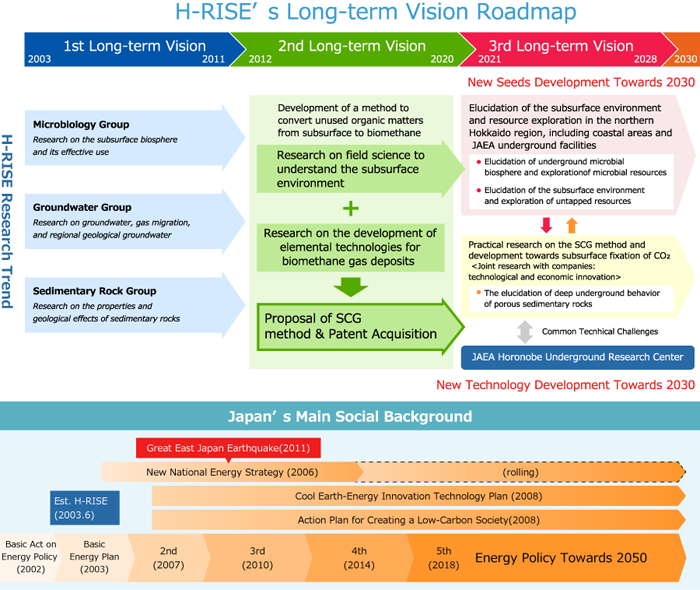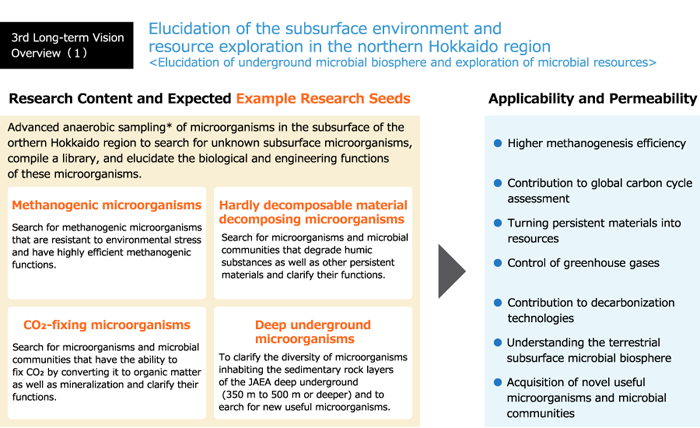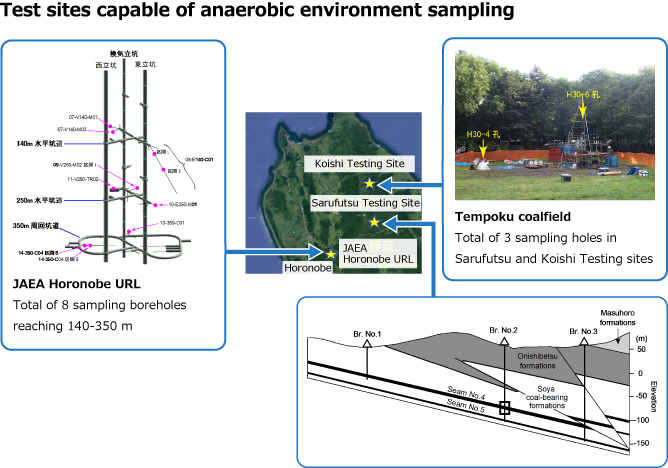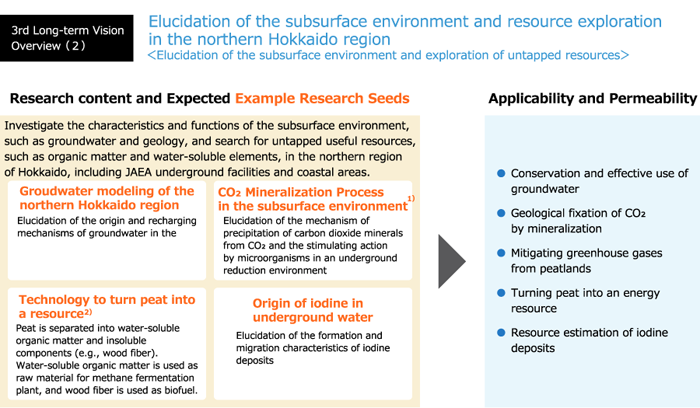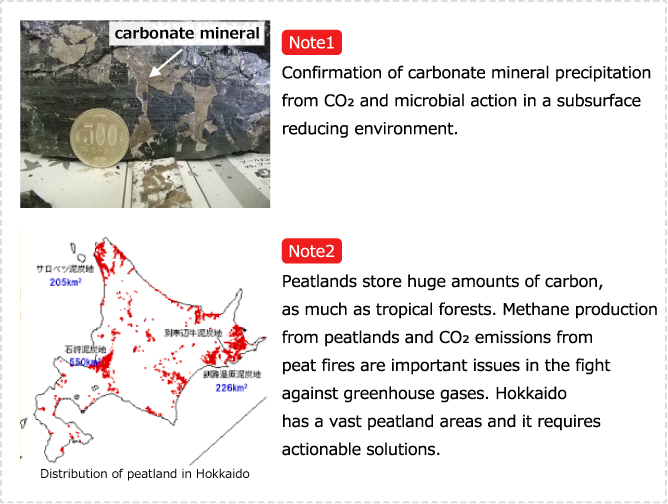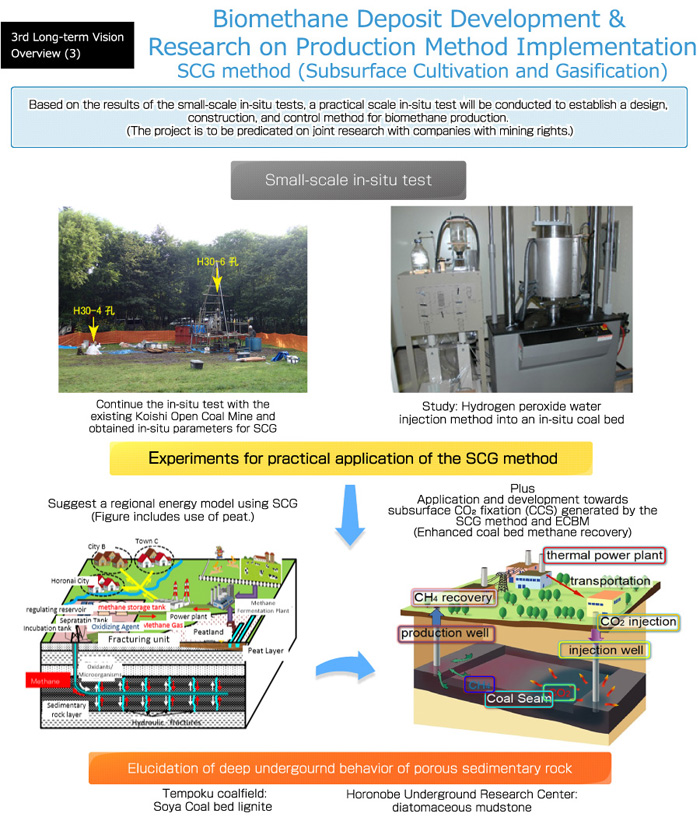What is H-RISE?
HOME > What is H-RISE? >
Long-term Vision (2021-2028)

Northern Advancement Center for Science & Technology
H-RISE
5-3 Sakaemachi, Horonobe-cho, Teshio-gun, Hokkaido, 098-3221, Japan.
TEL+81-1632-9-4112
FAX +81-1632-9-4113
H-RISE
5-3 Sakaemachi, Horonobe-cho, Teshio-gun, Hokkaido, 098-3221, Japan.
TEL+81-1632-9-4112
FAX +81-1632-9-4113
Long-term Vision (2021-2028)
Basic Policy
Important Research Agendas
In scientific and technological research, it is essential to formulate research plans with an eye towards the future. Therefore, in the eight-year research plan starting from FY2021, it was decided to look towards 2030 as the near future and to develop the research seeds and new technologies necessary for the 2030s. First, the specific goal for the research seed for 2030 is “Elucidation of the subsurface environment and search for resources in the northern Hokkaido region, including the coastal areas.” For this purpose, two priority tasks were set: “Elucidation of the subsurface microbial biosphere and search for microbial resources” and “Elucidation of the subsurface environment and search for untapped resources.” In addition, “Research on the practical application of subsurface biomethane production methods” was set as a specific target and priority issue for the development of new technologies by 2030.Characteristics of the research plan
- Background Research Results
The results of a series of studies that provide the backdrop to this research plan are presented below.-
Regarding subsurface microorganisms:
We have developed an anaerobic sampling method using the underground facilities at the Horonobe Underground Research Laboratory (Horonobe URL). We operate several sampling sites where subsurface microorganisms can be continuously collected. We have already discovered four new species of microorganisms (three methanogens and one sulfate-reducing bacterium) and registered them internationally, after elucidating their functions using this valuable research environment. Furthermore, we have succeeded in successive cultivation of microorganisms with excellent functions, such as methane production and organic matter decomposition, and have accumulated abundant research achievements and analytical know-how on subsurface microorganisms.
- Regarding the groundwater environment:
Water quality and isotope analysis of groundwater in northern Hokkaido have revealed that high concentrations of methane gas are dissolved in the region's groundwater, specifically biomethane produced by microorganisms (methanogens). In addition to discovering these biomethane resources, the formation environment and process of biomethane in the subsurface have been clarified, and the engineering applications of the biomethane have been proposed. Furthermore, we have discovered the existence of iodine resources in sedimentary rock formations in the northern Hokkaido area by analyzing dissolved substances in the groundwater. - As for the biomethane production method:
Based on the results of the above-mentioned research, we proposed a method to produce biomethane from organic matter undergoing geological formation using methanogens (SCG method) and obtained a patent for this method. In addition, we conducted research on a series of processes, from the decomposition of persistent organic matter undergoing geological formation by hydrogen peroxide water, to methane production from the decomposition products of methanogens. We have accumulated basic data and technical know-how. In addition, in-situ tests of the SCG method were carried out in the lignite beds of the Tempoku coalfield through joint research with several companies. The issues with its practical application have been clarified, and the phenomena have been verified.
-
Regarding subsurface microorganisms:
- Characteristics of the region
- Utilization of the JAEA Underground Research Laboratory (URL):
the only geological disposal research facility in Japan, the JAEA Deep Underground Research Laboratory (URL), is a valuable facility for collecting samples and conducting in-situ tests. - Distribution of lignite and peat beds:
According to Hokkaido's estimate, there are approximately 2 billion tons of lignite beds (Tempoku coalfield) in the northern Hokkaido region. This low-grade lignite coal can be converted into biomethane by microorganisms, which could lead to the recycling of the currently untapped resources. Furthermore, peat, which is widely distributed in the western part of northern Hokkaido, is a geomaterial that is difficult to use due to its high environmental load (so-called “nuisance”) and its effective utilization as a resource is desirable. -
Distribution of sedimentary rock layers containing high concentrations of methane gas:
Groundwater in the sedimentary rock layers in the northern Hokkaido area has been found to contain high concentrations of methane gas and iodine. In addition to these resources, the possibility of the existence of untapped resources has been noted in the subsurface of the northern Hokkaido area.
- Utilization of the JAEA Underground Research Laboratory (URL):
- Cooperation with external research institutions
We will conduct flexible and multifaceted research in collaboration with the JAEA Horonobe Underground Research Laboratory (Horonobe URL), the National Institute of Advanced Industrial Science and Technology (AIST), Hokkaido University, Hiroshima University, and other research institutes with experience in research on microorganisms, groundwater, and resource engineering, for example, Hokkaido University and Hiroshima University.
Expected Ripple Effects
- Subsurface microorganisms with useful engineering functions, such as methane production, degradation of persistent substances, carbon dioxide fixation, and organic matter production, will be explored, and their ecological functions are expected to be clarified. These new research seeds are expected to contribute to the development of new science and technology, such as the effective utilization of untapped and difficult-to-treat resources, the evaluation of the impact of the subsurface environment on the global carbon cycle, and the control of greenhouse gases and decarbonization technology. Furthermore, they are expected to contribute to Japan’s genetic resource strategy.
- We expect to elucidate the underground environment and its characteristics in the northern Hokkaido region, such as the groundwater model of the region, peat resource conversion technology, and the distribution and composition of water-soluble resources, such as iodine. These research seeds are expected to contribute to the development of new technologies, such as engineering applications within the groundwater environment and effective utilization of untapped resources.
- When the design, construction, and control methods of biomethane production are established, biomethane will be produced from as yet untapped resources, such as lignite coal, that exist in abundance in the northern Hokkaido region, and they are expected to be effectively used for local energy production. In addition, the overseas deployment and technology transfer of the biomethane production technology can be expected to make an international contribution to the effective utilization of untapped resources and the reduction of environmental burden.
Note* Advanced anaerobic sampling: Since the underground is in anaerobic state (no oxygen), groundwater and rocks need to be collected and analyzed so that they do not touch oxygen (air).















